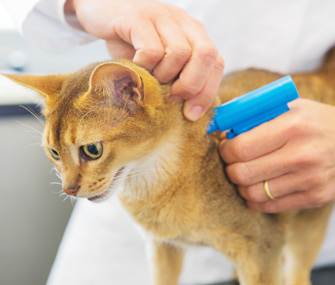8 Tips for Safe Travel With Your Pet
Published on September 11, 2015
Skip To

1. Implant a microchip. In the case of a lost pet, this greatly increases the chance you’ll be reunited. A microchip, a glass cylinder about the size of a grain of rice that’s inserted under your pet’s skin, holds a unique number that is associated with pet-owner information maintained in a national database. Animal shelters and veterinary clinics scan the chip to retrieve the pet’s number. They then access the pet’s number in the database to discover its owners.
2. Vaccinate. Update your pet’s vaccines — and depending on where you’re headed and whether your pet will be in contact with other animals, your veterinarian might recommend additional vaccinations. Talk with your veterinarian well in advance of your trip since some vaccines require a series of injections to be effective.
3. Prepare for parasites. Using broad-spectrum parasite-prevention products that control fleas, ticks and other parasites is key for dogs and cats, especially if you’re traveling to a warm climate where the risk of infestation is increased. Ask your veterinarian about which parasite-prevention products are best for your pet.
4. Avoid toxic plants. New surroundings bring new fauna that you may not be familiar with. A host of plants — such as azaleas, milkweeds and mushrooms — may cause vomiting or worse if eaten by pets. Lily ingestion can even cause death in cats. If you think your pet may have eaten a toxic plant, call your veterinarian or a poison control hotline immediately.
5. Be ready for emergencies. Don’t lug an entire file box on your trip, but do ask your veterinarian to prepare a quick history of your pet’s vaccinations, major illnesses and any medications he may be taking. (For air travel, a copy of your pet’s vaccine history should be attached to his carrier.) It’s also a good idea to find out ahead of time where the closest emergency care veterinary facility is in relation to your destination.
6. Bring familiar food. Pets are exposed to enough changes while traveling. Their eating habits shouldn’t be one of them. Why? Diarrhea + long car rides = major unpleasantness. Take food and treats along in case stores at your destination do not carry the same varieties your pet is accustomed to. And don’t forget to frequently offer your pet fresh water.
7. Use a carrier. Many airlines require pets to be in a carrier or crate. When traveling by car, keep cats and dogs in a secured carrier for their protection — and yours. Pets may do something you don’t expect, but if they’re in a crate they aren’t likely to cause an accident.
8. Consider letting pets stay home. Most cats are homebodies and would prefer to stay in their own world, so if possible, let them. Dogs are more likely to enjoy getting out, but not every dog loves travel. If leaving pets in your home under someone else’s care isn’t possible, consider boarding them at your veterinary clinic or a facility your veterinarian recommends. They’ll be safe, and they’ll still get a vacation.
More on Vetstreet.com:





